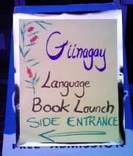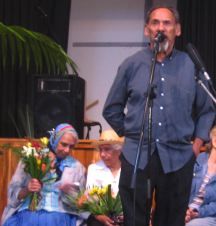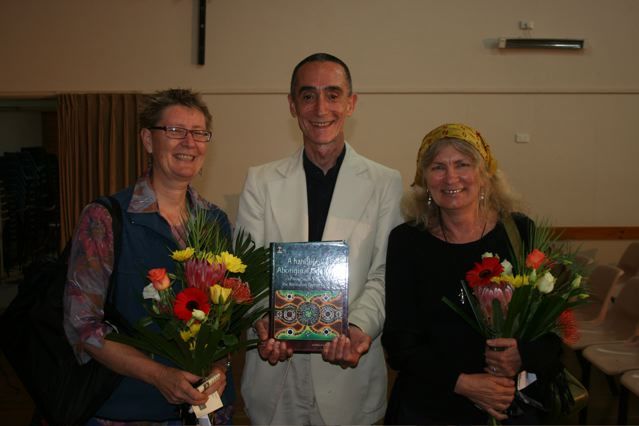[Updated with pictures – 21/11/08, 25/11/08, 30/11/08 ]

Three excellent books were launched yesterday, on a misty rainy day in the area of Nyambaga (Nambucca Heads). Long may they float, and God bless all who read them, buy them and review them.
They are:
- Gumbaynggirr dictionary and learner’s grammar = Gumbaynggirr bijaarr jandaygam, ngaawa gugaarrigam, by Steve Morelli, Nambucca Heads, N.S.W. : Muurrbay Aboriginal Language and Culture Co-operative, 2008.
- Barriyala – Let’s work : Gumbaynggirr language student workbook, by Julie Long.
Nambucca Heads, N.S.W. : Muurrbay Aboriginal Language and Culture Co-Operative, 2007. - and the most significant general reference work on Indigenous intellectual traditions published in a long time, A handbook of Aboriginal languages of New South Wales and the Australian Capital Territory, by James Wafer, and Amanda Lissarrague with a chapter by Jean Harkins. Nambucca Heads, N.S.W. Muurrbay Aboriginal Language and Culture Co-Operative, 2008.
You can order the books from Muurrbay. More about the books below, but now to the launch.

Photo from Muurrbay: L-R Aunty Vilma Moylan, Aunty Jessie Williams, Uncle Ken Walker
“Thank you for supporting us as a people, and keep the spirit alive eh?” That’s how the Master of Ceremonies, and Chairman of Muurrbay, Uncle Ken Walker ended a cheerful, joking, rousing morning’s celebration of Gumbaynggirr language survival and revival. When you have 200 people to help launch three books, everything connects.


The welcome to country was delivered by young Ricky Buchanan in his St Joseph’s College school uniform, and translated by Dallas Walker. Ricky’s a grandson of the late Uncle Harry ‘Tiger’ Buchanan,
- who, in the early 1970s, after a time speaking his language Gumbaynggirr only to God and his dog Waanyji, taught it to Diana Eades,

- who invoked his views on eliciting the relative clause in her launch of the 392 page Gumbaynggirr Dictionary and Learners Grammar, proof-read by Dallas Walker and compiled by Gagu (Brother) Steve Morelli,

- who’s been working since 1986 to help revive the language with elders past and present,
- among whom were Uncle Reg Davis who smoked the books
- Uncle Martin Ballangarry (“I’m little bit winded”) who enthusiastically sang and directed young boys dancing shake-a-leg, and miming kangaroos and buurrga (freshwater eel), and directed boys and girls singing the Boat song (remembered by Uncle Lennie de Silva, now passed away), together with Sharon Smith,
- who did the cover designs and illustrations for the books, and danced with young girls miming oyster and pippi gathering
- Aunty Cheryal Blair who’d come from Queanbeyan to sing with the Nambucca Valley Elders Choir Giinagay ‘How are you?’ a song of conversation starters (good way of remembering them)
- Aunty Jessie Williams, a birthday girl along with Aunty Vilma Moylan, who had Happy Birthday sung to them in Gumbaynggirr by Des Williams, and Gary Williams, language researcher for Many Rivers Aboriginal Languages Centre,
- who’d worked in Alice Springs with Jim Wafer
- who compiled the 844 page Handbook of New South Wales Languages together with Amanda Lissarague
- who’d been a student of Diana Eades at University of New England, along with Anna Ash
- who manages the Muurrbay Aboriginal language Corporation
- which published these two books as well as the Barriyala language learning books
- which were compiled by Julie Long/ and launched by Claire Mellon, headmistress of St Mary’s School, Bowraville,
- where Ricky learned Gumbaynggirr.
- which were compiled by Julie Long/ and launched by Claire Mellon, headmistress of St Mary’s School, Bowraville,
- which published these two books as well as the Barriyala language learning books
- who manages the Muurrbay Aboriginal language Corporation
- who’d been a student of Diana Eades at University of New England, along with Anna Ash
- who compiled the 844 page Handbook of New South Wales Languages together with Amanda Lissarague
- who’s been working since 1986 to help revive the language with elders past and present,
- who invoked his views on eliciting the relative clause in her launch of the 392 page Gumbaynggirr Dictionary and Learners Grammar, proof-read by Dallas Walker and compiled by Gagu (Brother) Steve Morelli,
Language revival is songs, is dance, is the old and old mingling with the new and young, is jokes, is laughter, is a collaboration. ‘Serendipity doesn’t just happen’ said Gagu Steve.
And indeed the books have all the virtues of building on preceding work. Each deserves a full review of its own, but marking calls, and so I’ll just give brief teasers on the dictionary and the handbook.
The Gumbaynggirr dictionary and learner’s grammar builds on the previous publication (2001). But it is greatly extended. There are 2,700 entries and these have the great virtue of indicating sources. There’s also a separate section useful for language revivers which lists the words coined recently for language revival and the principles and practices adopted in coining words (137-152), and another on language change (371-375). There’s a substantial learner’s grammar (241-372). And there’s a fine map (p.197) of clan and dialect names and place-names in Gumbaynggirr country (dual naming coming up?) The book concludes with a section on Aboriginal families, aimed at revealing the complexity of the Gumbaynggirr kinship, moiety and section system to those who know nothing about different kinship systems. Plenty of examples, diagrams, colours. (Claimer: we bought this)
The handbook, ah… (Disclaimer: I was given a copy, to my astonished delight)
Once upon a time we believed that R. M. W. Dixon’s massively funded work at ANU would produce such a book for the whole of Australia – a book which would evaluate what is known about all the languages of Australia, and where to go to find out more. A book that would build on Norman Tindale’s immense work [1].
That never happened, and so in the late 1970s, Jim Wafer, who was then working for the Institute for Aboriginal Development, organised the first regional source-book: Menning, Kathy, and Nash, David (ed.). 1981. Sourcebook for Central Australian languages. Alice Springs: Institute for Aboriginal Development. Cheaply produced and crappily bound, but rich in content.
The NSW Handbook builds on what was learned from that book and its successors, and from generous collaboration with many people working on languages of NSW and the ACT. It’s handsomely produced, durably bound (doesn’t say if the paper’s acid-free, sigh). And the content!
Fourteen evaluation chapters on language groups by area, and fourteen chapters of word-lists from those languages. A chapter by Jean Harkins on the new languages that evolved in contact situations, and word lists from those languages. A densely packed 47 page chapter by Jim Wafer making sense of the fragments known about kinship systems in NSW. It could have been a monograph.
The template for information for the chapters consists of:
- Introduction and rationale for grouping
- Name and classification
- Bibliography: includes a careful revision of the Tindale sources, and a note if any electronic files for the language exist in ASEDA, the Aboriginal Studies Electronic Data Archive (yes, you can get copies of much of this material, check here).
- Present number of speakers and their location
- People who have worked on the language
- Contemporary word-lists
- Texts
- Contemporary grammar or sketch grammar
- Language programs
- Language learning material
- Literacy material
And to end at the beginning, pp.viii and ix gives a list of the collaborations between speakers of Indigenous languages and language documenters that form the basis for language revival and survival programs, and for this book. The list ranges in time from some 16 or so named people of the Sydney area who taught William Dawes and other First Fleeters, to Uncle Lennie de Silva who handed on Gumbaynggirr to the present generation.
All hail to the Muurrbay Aboriginal Language & Culture Co-operative for publishing these books. Their publication establishes:
- Muurrbay as one of the few major players in publishing books in and about Indigenous languages (the others being IAD Press, Magabala Books, Wangka Maya and Pacific Linguistics). Books whose value is enduring.
- Christine Bruderlin and Mark MacLean as the most professional and elegant designers of reference books on languages
- and Many Rivers Aboriginal Languages Centre as a model for affectionate and respectful collaborations on language and cultural revival.

Left-to-right: Jean Harkins, Jim Wafer, Amanda Lissarrague
[1] Norman B. Tindale. 1974, Aboriginal tribes of Australia: their terrain, environmental controls, distribution, limits and proper names. Berkeley, Los Angeles, London: University of California Press).
 Follow
Follow
What a beautiful way you have with words, Jane!! And at lightning speed!!
Thanks for your lovely input!
Gugs
I haven’t had time for ages to explore and enjoy Gumbaynggir language information so it was a wonderful surprise to see what has been achieved in the years that I’ve been in Brisbane. Congratulations to everyone. I noticed my grandmother’s list in the publications – did you know that my g.grandfather Charles Layton was the other Nymboidan mentioned in Laves’ articles? I look forward to receiving the new book on the language. Kind regards.
Hi,
I have a need to have the words to “happybirthday” in the Gumbaynggirr language an you help?